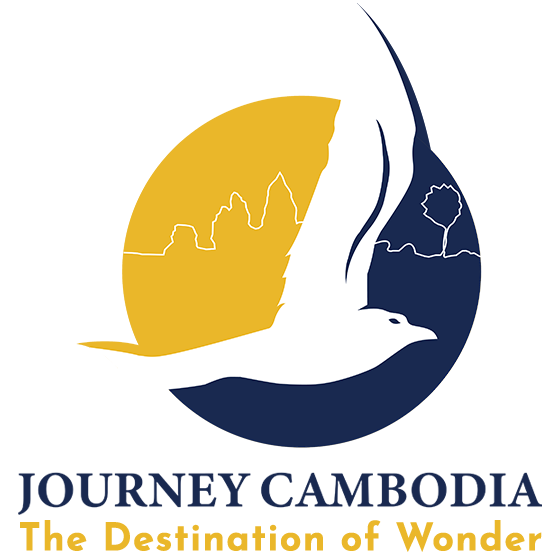This Secret Temple Outshines Angkor Wat — And Almost No One Knows It! It’s taller, emptier, and feels like you’ve stepped into a lost world—welcome to Koh Ker Temple.
Why Smart Explorers Are Ditching Crowded Angkor Wat for This Mind-Blowing 1,000-Year-Old Pyramid That Lets You Climb to the Top (And Take Epic Photos Without Fighting Tourists)
Koh Ker Temple sits quietly in Cambodia’s jungle. This UNESCO World Heritage site beats Angkor Wat in many ways. Koh Ker offers empty temples, amazing photos, and a real adventure. Most tourists still don’t know about this place.
Overview
Koh Ker Temple is a 1,000-year-old pyramid complex in northern Cambodia that served as the Khmer Empire’s capital from 928 to 944 AD. Located 120 kilometers from Siem Reap, this remote temple site features a climbable 36-meter seven-tiered pyramid called Prasat Thom, making it unique among Cambodia’s ancient temples.
Unlike crowded Angkor Wat, Koh Ker receives only 105,464 visitors annually and offers an authentic jungle temple experience. The site became a UNESCO World Heritage location in 2023 and was ranked #34 on New York Times’ top global destinations for 2024. Key features include:
- Prasat Thom pyramid – the only climbable temple tower in Cambodia
- 180+ temple structures spread across 8,100 hectares of jungle
- Ancient Khmer capital built by King Jayavarman IV
- Red laterite temples with exceptional stone carvings
Perfect for travelers seeking adventure and authentic photos, Koh Ker provides the temple experience Angkor Wat offered before mass tourism. Visitors can climb ancient pyramids, walk through jungle temples, and capture amazing photos without crowds.
This UNESCO World Heritage site offers something Angkor Wat doesn’t!
1. Koh Ker Temple: The 36-Meter Pyramid That Changed Everything
Koh Ker was once the capital of the mighty Khmer Empire. King Jayavarman IV built this remote temple complex between 928 and 944 AD. The main temple, Prasat Thom, stands 36 meters tall as a seven-tiered pyramid. You can actually climb to the top!
This isn’t your typical temple design. While Angkor Wat follows the traditional temple-mountain style, Koh Ker breaks all the rules. The Koh Ker Style features a unique linear layout. Temples stretch along an 800-meter path through the jungle.
What makes Koh Ker special:
- Prasat Thom: The massive pyramid you can climb
- Prasat Prang: Features amazing stone carvings
- Prasat Pram: Trees grow through the temple walls
- Prasat Krahom: The red temple with perfect stonework
- Prasat Balang: Shows the skill of ancient builders
The ancient city was called Lingapura or Chok Gargyar. It housed the empire’s tallest Shiva lingas and featured a huge water reservoir called a baray. Monolithic stone blocks weighing tons were moved here without modern machines.
Skip the crowded selfie-sticks at Angkor Wat and experience what real temple exploration feels like!
Our Koh Ker and Boeng Mealea Jungle Explorer Tour takes you deep into Cambodia’s forgotten jungle temples where:
✅ You can climb a 1,000-year-old pyramid (try that at Angkor Wat!)
✅ Take Instagram photos with ZERO tourists in the background
✅ Walk through temples being eaten by massive jungle trees
✅ See the “Red Temple” with mind-blowing stone carvings
✅ Experience what Indiana Jones movies are based onThis isn’t your typical temple tour. This is pure adventure.
While everyone else fights crowds at Angkor Wat, you’ll have entire ancient cities to yourself. Your friends will ask “Where did you take THOSE photos?!”
Book Your Jungle Temple Adventure Now →
Warning: Once you experience temples the way they’re meant to be seen, regular tourist sites will feel boring forever.
2. Why Koh Ker Temple Beats Angkor Wat (And It’s Not Even Close)
Let me be honest with you. I’ve been to both places many times. Koh Ker wins hands down for the real temple experience.
Visitor numbers tell the story:
| Temple Complex | Annual Visitors | Crowding Level | Photo Quality |
|---|---|---|---|
| Angkor Wat | 900,000+ | Extremely High | Tourist-filled |
| Koh Ker | 105,464 | Low | Perfect shots |
| Preah Vihear | 92,966 | Moderate | Good |
Koh Ker saw 71.2% visitor growth in 2023. But it still feels empty compared to Angkor Wat. You’ll have temples almost to yourself.
Why smart travelers choose Koh Ker:
- No crowds: Take photos without fighting other tourists
- Climb the pyramid: Angkor Wat doesn’t let you climb anymore
- Jungle setting: Feel like an explorer in the wild
- Authentic experience: See temples as they were meant to be
- Better photos: Your Instagram will thank you
The jungle temple setting makes every photo look amazing. Massive trees wrap around stone walls. Sunlight filters through thick leaves. You’ll feel like you stepped into an adventure movie.
3. The Secret History That Made Koh Ker Temple Cambodia’s Lost Capital
Picture this: In 928 AD, King Jayavarman IV got tired of Angkor. He packed up the entire Khmer Empire capital and moved it 120 kilometers northeast. The new city became known as Lingapura – the city of lingas.
The timeline that changed everything:
- 928 AD: Jayavarman IV establishes Koh Ker as capital
- 928-944 AD: Massive building program creates 180+ temples
- 944 AD: Capital returns to Angkor after the king’s death
- 15th century: Koh Ker abandoned to the jungle
- 2023: Becomes UNESCO World Heritage site
The king didn’t just build a few temples. He created an entire sacred city. Workers carved a massive sacred pond called Rahal. They built the baray to store water for the dry season. Laterite stone and red brick temples rose from the forest floor.
What made Koh Ker different:
The Koh Ker Style changed temple design forever. Instead of building up like mountains, temples spread out in lines. The seven-tiered pyramid of Prasat Thom stood as the centerpiece. It was unlike anything built before or since in Cambodia.
4. New York Times Says Koh Ker Temple is #34 Best Place to Visit (Here’s Why)
The secret is out! Koh Ker made the New York Times’ top 52 global destinations for 2024. Fodor’s Travel ranked it top 3 in Asia for 2025. These aren’t small travel blogs – these are the big names in travel.
Recent recognition:
- 2023: UNESCO World Heritage status
- 2024: New York Times #34 global destination
- 2025: Fodor’s top 3 Asia destinations
Revenue numbers show the growth:
- 2024 foreign visitor revenue: $278,715
- Total visitors in 2023: 105,464 (up 71.2%)
- Average revenue per visitor: $15
Compare that to Angkor Wat’s $41.91 million from 900,000 visitors. Koh Ker makes less money but offers way more value to visitors.
What travel experts love about Koh Ker:
- Authentic jungle experience
- Climbable pyramid structure
- Photography opportunities
- Peaceful atmosphere
- Historical significance
Cambodia is seeing huge tourism growth. The country expects 7.5 million international tourists in 2025. Koh Ker will get its share of this boom.
5. How to Experience Koh Ker Temple Like a Pro Explorer
Getting to Koh Ker takes planning. The temple sits 120 kilometers from Siem Reap. That’s about 2.5 hours on bumpy roads. But trust me – it’s worth every minute.
Best ways to visit:
- Private day tour from Siem Reap
- Combined with Boeng Mealea temple
- Overnight trip from Preah Vihear
- Part of a northern Cambodia circuit
The Journey Cambodia team offers great Koh Ker tours. They know the best times to visit and which temples to see first.
What to expect at each temple:
Prasat Thom (The Big Temple):
- Height: 36 meters
- Climbable: Yes (with care)
- Best time: Early morning
- What to see: Panoramic jungle views
Prasat Prang:
- Features: Stone carvings
- Condition: Well preserved
- Photo tip: Great for detail shots
Prasat Pram:
- Special feature: Trees growing through walls
- Instagram factor: Extremely high
- Best angle: From the side entrance
Prasat Krahom (Red Temple):
- Color: Deep red laterite stone
- Carvings: Some of the best at Koh Ker
- Lighting: Perfect in afternoon
6. Koh Ker Temple vs Angkor Wat: The Numbers Don’t Lie
Let me show you why Koh Ker gives you more bang for your buck:
Experience comparison:
| Factor | Koh Ker | Angkor Wat |
|---|---|---|
| Crowd level | Almost empty | Packed |
| Climbing allowed | Yes (pyramid) | No |
| Photo quality | Perfect | Tourist-filled |
| Adventure factor | High | Low |
| Authenticity | Maximum | Commercialized |
| Time needed | Full day | Half day |
Koh Ker covers 8,100 hectares with only 105,464 annual visitors. That’s just 13 visitors per hectare! Angkor Wat crams 40,615 visitors per hectare. You do the math.
What you get at Koh Ker:
- 24 accessible temples out of 180+ total structures
- 13.3% accessibility rate (more opening soon)
- 1:7.5 visitor-to-monument ratio
- Zero commercial vendors inside the site
- Real jungle exploration between temples
The remote temple complex requires more effort to reach. But that effort pays off with an authentic experience. You’ll understand why King Jayavarman IV chose this spot for his capital.
7. Planning Your Koh Ker Temple Adventure: Everything You Need to Know
When to visit:
- Best months: November to March (dry season)
- Perfect time: Early morning (7-9 AM)
- Avoid: April to June (too hot)
- Rainy season: July to October (muddy roads)
What to bring:
- Good walking shoes (essential)
- Plenty of water
- Camera with extra batteries
- Sun protection
- Light backpack
- Insect repellent
Physical requirements:
- Moderate fitness level needed
- Climbing involves steep steps
- Jungle walking on uneven ground
- About 3-4 hours of walking total
Transportation options:
- Private car with driver (recommended)
- Cost: $80-120 for full day
- Comfort: High
- Flexibility: Maximum
- Motorbike (for adventurous travelers)
- Cost: $10-15 per day
- Comfort: Low
- Risk: Higher
- Tour group
- Cost: $50-80 per person
- Convenience: High
- Flexibility: Limited
8. The Koh Ker Temple Photo Guide That’ll Make Your Friends Jealous
Let’s talk photography. Koh Ker offers some of the best temple photos in Cambodia. Here’s how to get those perfect shots:
Best photography spots:
- Prasat Thom summit: Panoramic jungle views
- Prasat Pram tree temples: Instagram gold
- Sacred pond reflections: Mirror-like water shots
- Temple doorways: Perfect framing opportunities
- Jungle paths: Adventure-style walking shots
Camera settings that work:
- Golden hour: Shoot 30 minutes after sunrise
- Aperture: f/8 to f/11 for sharp temple details
- ISO: Keep below 400 for clean images
- Composition: Use temple doorways as natural frames
Pro photography tips:
- Arrive before other tourists (if any!)
- Use the laterite stone’s red color as a focal point
- Capture the scale by including people in shots
- Monolithic stone blocks make great foreground elements
- Shoot both wide landscapes and detailed carvings
Drone photography: Currently not allowed at Koh Ker. Stick to ground-based shots for now.
9. Cambodia Beyond Koh Ker Temple: Your Complete Adventure Guide
Koh Ker sits in northern Cambodia, far from the usual tourist trail. But this location opens up amazing travel opportunities. You can combine Koh Ker with other incredible sites.
Perfect combinations:
Option 1: Temple Circuit
- Day 1: Koh Ker and Boeng Mealea
- Day 2: Preah Vihear temple
- Day 3: Return to Siem Reap via Beng Mealea
Option 2: Cultural Immersion
- Morning: Koh Ker exploration
- Afternoon: Local village visits
- Evening: Traditional Khmer dinner
Option 3: Adventure Route
- Koh Ker temple climbing
- Jungle trekking
- River boat trips
- Camping under stars
Base locations:
Siem Reap: The main tourist hub
- Distance to Koh Ker: 120km (2.5 hours)
- Hotels: Luxury to budget options
- Food: International and Khmer cuisine
- Services: Tours, guides, transportation
Phnom Penh: Cambodia’s capital
- Distance to Koh Ker: 320km (5 hours)
- Attractions: Royal Palace, Silver Pagoda
- History: Tuol Sleng, Choeung Ek
- Culture: National Museum
Preah Vihear: Mountain temple town
- Distance to Koh Ker: 80km (1.5 hours)
- Stay: Basic guesthouses
- Combine: Both temples in 2 days
- Views: Incredible mountain scenery
10. The Koh Ker Temple Conservation Story You Should Know
Koh Ker faces real challenges. More visitors mean more pressure on ancient stones. The jungle that protected these temples for centuries now needs our help to keep protecting them.
Current conservation efforts:
- UNESCO monitoring: Regular site inspections
- Visitor limits: Planned daily caps
- Path improvements: Better walkways to protect temples
- Local training: Community guides and guards
- Research programs: Ongoing archaeological work
What travelers can do:
- Follow marked paths only
- Don’t touch temple carvings
- Pack out all trash
- Support local guides
- Choose responsible tour operators
The Journey Cambodia team works with local communities. They make sure tourism money helps protect Koh Ker for future visitors.
Challenges ahead:
- Road improvements: Better access vs. environmental impact
- Facility development: Visitor services vs. site integrity
- Tourist growth: Balancing numbers with preservation
- Climate change: Protecting against weather damage
Why this matters: Koh Ker survived 1,000 years in the jungle. With careful management, it can survive tourism too.
11. Koh Ker Temple Practical Guide: Money, Time, and Logistics
Let’s get down to the real stuff. How much does Koh Ker cost? How long do you need? What’s the actual process?
Cost breakdown:
| Item | Price Range | Notes |
|---|---|---|
| Entrance ticket | $10 | For foreigners |
| Private car + driver | $80-120 | Full day from Siem Reap |
| Guide fee | $30-50 | Optional but recommended |
| Meals | $15-25 | Lunch stops en route |
| Total per person | $45-85 | Depending on group size |
Time requirements:
- Travel time: 5 hours total (round trip)
- Temple exploration: 3-4 hours
- Total day: 8-9 hours
- Best start time: 6:30 AM from Siem Reap
Step-by-step visit process:
- Book transportation (private car recommended)
- Start early (6:30 AM departure)
- Stop for breakfast (en route)
- Arrive at Koh Ker (around 9 AM)
- Buy entrance ticket (ticket booth)
- Start with Prasat Thom (the main pyramid)
- Explore other temples (3-4 more temples)
- Lunch break (local restaurant)
- Return journey (2:30 PM departure)
- Arrive Siem Reap (5-6 PM)
Money-saving tips:
- Group bookings: Split car costs (4 people = $20-30 each)
- Pack lunch: Avoid restaurant markups
- Local driver: Often cheaper than tour companies
- Combine trips: Add Boeng Mealea same day
12. Koh Ker Temple Safety and What Nobody Tells You
Safety first – Koh Ker is remote. Cell phone coverage is spotty. The nearest hospital is hours away. But don’t let that scare you off! With basic precautions, Koh Ker is totally safe.
Real safety considerations:
Temple climbing safety:
- Prasat Thom steps are steep and narrow
- No safety railings on the pyramid
- Stone can be slippery when wet
- Take your time – there’s no rush
Jungle safety:
- Stick to marked paths always
- Koh Ker was fully demined in 2008
- Watch for tree roots and holes
- Bring insect repellent
Weather safety:
- Start early to avoid afternoon heat
- Carry plenty of water (2 liters minimum)
- Sun protection is essential
- Rainy season roads can flood
Health preparation:
- Basic first aid kit
- Any personal medications
- Anti-diarrheal medicine
- Electrolyte supplements
What locals don’t always mention:
- Bathroom facilities are very basic
- No food vendors inside the temple area
- ATMs don’t exist near Koh Ker
- Bring cash for everything
Emergency contacts:
- Tourist police: 012 942 484
- Medical emergency: 119
- Your hotel/guesthouse number
- Driver’s phone number
The truth about danger: Koh Ker is safer than most tourist areas. The biggest risks are dehydration and twisted ankles. Use common sense and you’ll be fine.
Final Thoughts: Why Koh Ker Temple Changed How I See Cambodia
After visiting Koh Ker more than twenty times, I still get excited about going back. This jungle temple shows what Angkor Wat used to be like before mass tourism. Standing on top of Prasat Thom, looking out over endless forest, you feel the real power of the Khmer Empire.
Your next steps:
- Book your trip: Contact Journey Cambodia for the best Koh Ker tours
- Plan for weather: Visit during dry season for best experience
- Bring good shoes: You’ll do lots of walking and climbing
- Start early: Beat the heat and have temples to yourself
Koh Ker Temple isn’t just another temple visit. It’s stepping back 1,000 years into Cambodia’s golden age. The seven-tiered pyramid awaits your climb.
Helpful Resources:
- UNESCO World Heritage Centre – Official Koh Ker designation details
- Cambodia Tourism Board – Current travel updates and requirements
- Journey Cambodia Tours – Professional Koh Ker expedition planning









